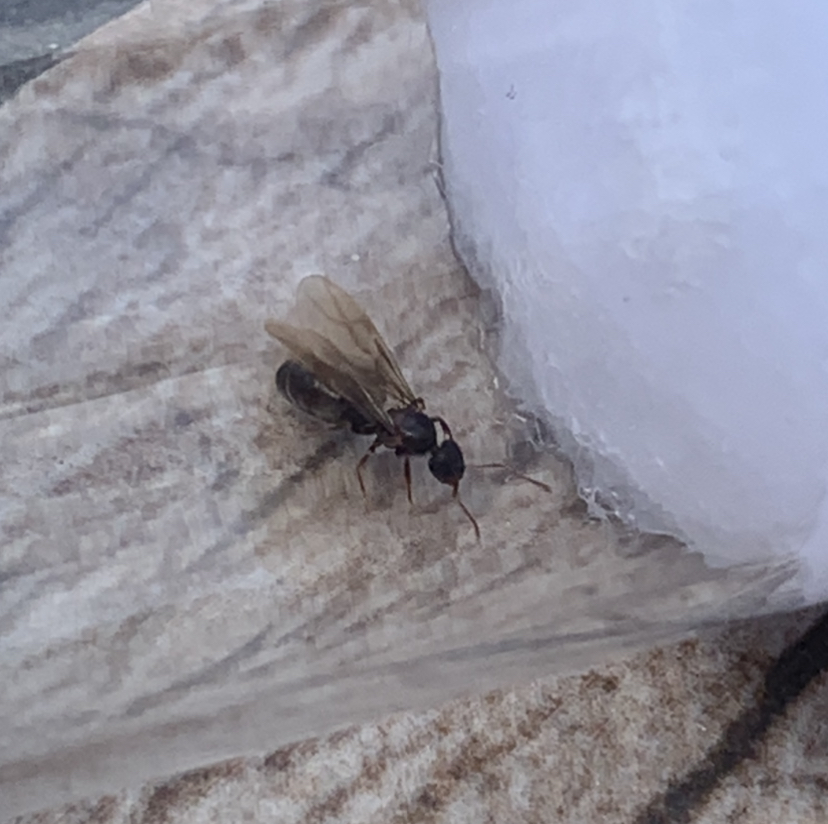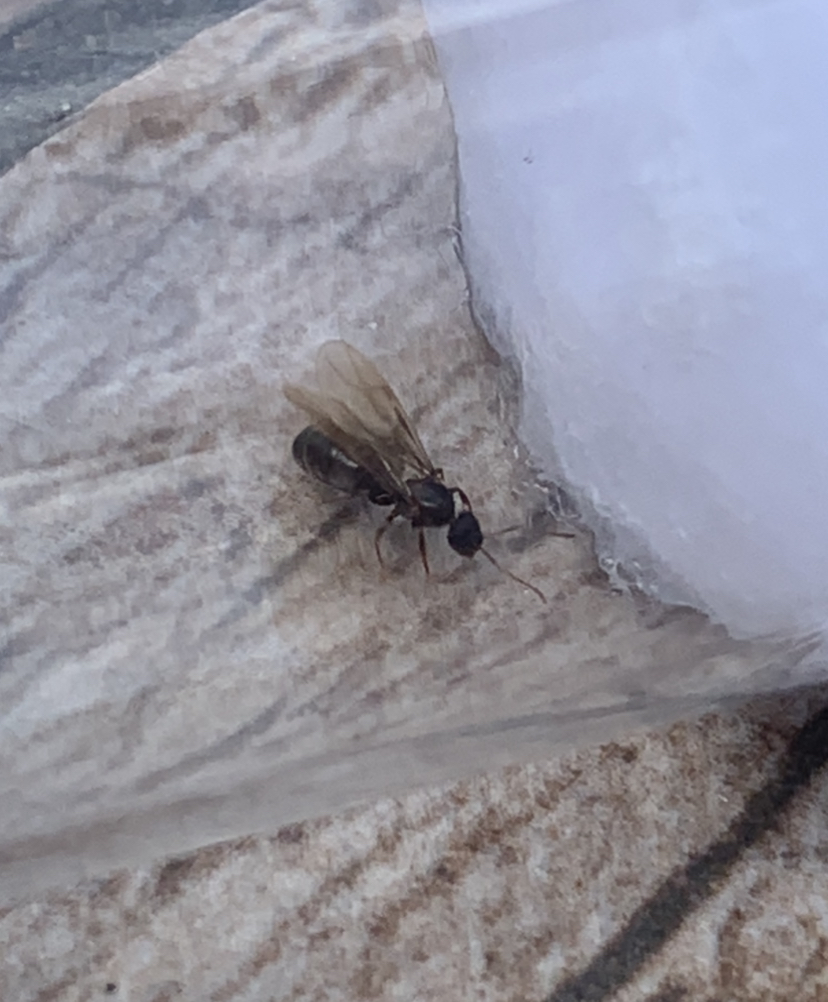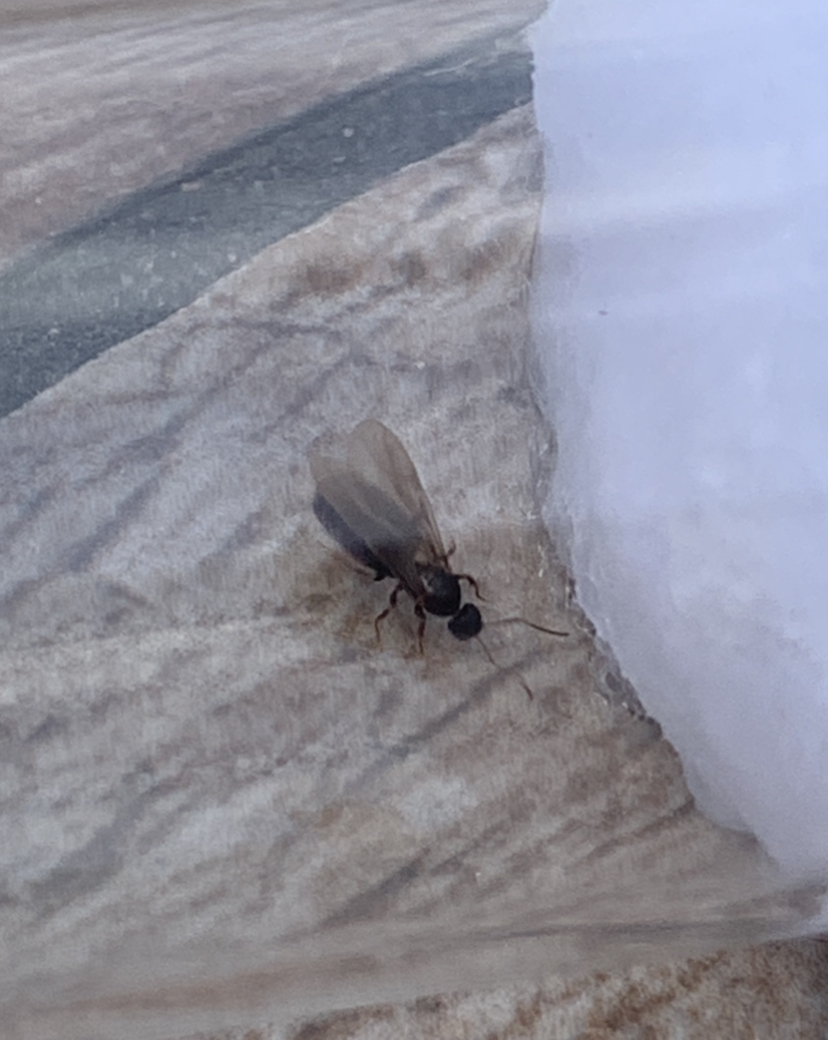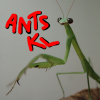- Formiculture.com
- Forums
- Gallery
- Members
- Member Map
- Chat
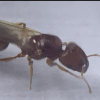
Illinois 5-21-2021 Possibly Nylanderia, found in pool
Started By
yibsi
, May 21 2021 10:04 AM

Best Answer Manitobant , May 21 2021 - 10:12 AM
Yeah that looks like nylanderia, possibly N. parvula.
Go to the full post 
8 replies to this topic
#1
 Offline
-
Posted May 21 2021 - 10:04 AM
Offline
-
Posted May 21 2021 - 10:04 AM
So I sold my colonies as I recently moved across state lines to Illinois from Indiana, and well today I found the first new queens here at my new home! Found them both in my pool, the one seemed dead however she eventually perked right up. They are both INCREDIBLY fast moving. Currently at the time of writing this book can see that one of the queens are currently in the process of removing her wings, so I know that at least she is fertile.
They are both 4 millimeters exactly, they both are a dark brownish reddish black, with bright orange feet and tips of antennae
They both are incredibly fast and can climb glass with no issues what so ever.
5-21-2021
They look similar to a nylanderia queen I found a few years back, so possibly nylanderia?
My main question is are these gals polygynous and what species are they? I’ve always wanted a polygynous super-colony so any info would be appreciated.
Thanks for the help!
They are both 4 millimeters exactly, they both are a dark brownish reddish black, with bright orange feet and tips of antennae
They both are incredibly fast and can climb glass with no issues what so ever.
5-21-2021
They look similar to a nylanderia queen I found a few years back, so possibly nylanderia?
My main question is are these gals polygynous and what species are they? I’ve always wanted a polygynous super-colony so any info would be appreciated.
Thanks for the help!
Nylanderia parvula - 4 queen polygynous colony with larvae + devoloping workers
Camponotus pennsylvanicus - 1 queen with 2 cocoons, and a few larvae and eggs
Tetramorium immigrans - 3 colonies, first nanetics!
Formica pallidifulva - 1 queen, 8-10 eggs
Tetramorium atratulum - 1 queen with roughly 17 host workers
![]() Pheidole pilifera - 1 queen! recently caught!
Pheidole pilifera - 1 queen! recently caught! ![]()
Solenopsis Molesta - 2 queens so far, polygenous set-up
---------------------------------------------------
My Ant Journal - yibsi’s Wonderful Ant Keeping Journal 5-22-21 - Ant Keeping Journals - Ants & Myrmecology Forum (formiculture.com)
My T. Atratulum Journal - https://www.formicul...ontinued/page-2
#2
 Offline
-
Posted May 21 2021 - 10:12 AM
Best Answer
Offline
-
Posted May 21 2021 - 10:12 AM
Best Answer
Yeah that looks like nylanderia, possibly N. parvula.
- CheetoLord02 and yibsi like this
My journals:
Polyergus Mexicanus: https://www.formicul...gs/#entry175528
Lasius minutus: https://www.formicul...cs/#entry174811
Lasius latipes: https://www.formicul...gs/#entry206449
General acanthomyops journal: https://www.formicul...yops-with-eggs/
Polyergus Mexicanus: https://www.formicul...gs/#entry175528
Lasius minutus: https://www.formicul...cs/#entry174811
Lasius latipes: https://www.formicul...gs/#entry206449
General acanthomyops journal: https://www.formicul...yops-with-eggs/
#3
 Offline
-
Posted May 21 2021 - 10:52 AM
Offline
-
Posted May 21 2021 - 10:52 AM
Yeah that looks like nylanderia, possibly N. parvula.
Are they polygynous? I can't find that much info on N. parvula
Nylanderia parvula - 4 queen polygynous colony with larvae + devoloping workers
Camponotus pennsylvanicus - 1 queen with 2 cocoons, and a few larvae and eggs
Tetramorium immigrans - 3 colonies, first nanetics!
Formica pallidifulva - 1 queen, 8-10 eggs
Tetramorium atratulum - 1 queen with roughly 17 host workers
![]() Pheidole pilifera - 1 queen! recently caught!
Pheidole pilifera - 1 queen! recently caught! ![]()
Solenopsis Molesta - 2 queens so far, polygenous set-up
---------------------------------------------------
My Ant Journal - yibsi’s Wonderful Ant Keeping Journal 5-22-21 - Ant Keeping Journals - Ants & Myrmecology Forum (formiculture.com)
My T. Atratulum Journal - https://www.formicul...ontinued/page-2
#4
 Offline
-
Posted May 21 2021 - 12:21 PM
Offline
-
Posted May 21 2021 - 12:21 PM
most nylanderia are i think.Yeah that looks like nylanderia, possibly N. parvula.
Are they polygynous? I can't find that much info on N. parvula
- yibsi likes this
My journals:
Polyergus Mexicanus: https://www.formicul...gs/#entry175528
Lasius minutus: https://www.formicul...cs/#entry174811
Lasius latipes: https://www.formicul...gs/#entry206449
General acanthomyops journal: https://www.formicul...yops-with-eggs/
Polyergus Mexicanus: https://www.formicul...gs/#entry175528
Lasius minutus: https://www.formicul...cs/#entry174811
Lasius latipes: https://www.formicul...gs/#entry206449
General acanthomyops journal: https://www.formicul...yops-with-eggs/
#5
 Offline
-
Posted May 21 2021 - 12:58 PM
Offline
-
Posted May 21 2021 - 12:58 PM
most nylanderia are i think.
Yeah that looks like nylanderia, possibly N. parvula.
Are they polygynous? I can't find that much info on N. parvula
Ok, thanks!
Nylanderia parvula - 4 queen polygynous colony with larvae + devoloping workers
Camponotus pennsylvanicus - 1 queen with 2 cocoons, and a few larvae and eggs
Tetramorium immigrans - 3 colonies, first nanetics!
Formica pallidifulva - 1 queen, 8-10 eggs
Tetramorium atratulum - 1 queen with roughly 17 host workers
![]() Pheidole pilifera - 1 queen! recently caught!
Pheidole pilifera - 1 queen! recently caught! ![]()
Solenopsis Molesta - 2 queens so far, polygenous set-up
---------------------------------------------------
My Ant Journal - yibsi’s Wonderful Ant Keeping Journal 5-22-21 - Ant Keeping Journals - Ants & Myrmecology Forum (formiculture.com)
My T. Atratulum Journal - https://www.formicul...ontinued/page-2
#6
 Offline
-
Posted May 21 2021 - 1:01 PM
Offline
-
Posted May 21 2021 - 1:01 PM
Nice find! You could try grouping them, but they grow crazy fast with even just one queen. Mine went from a single queen, to staging a nuptial flight in my living room in under a year.
- TennesseeAnts and yibsi like this
"The ants are a people not strong, yet they prepare their meat in the summer." Prov. 30:25
Keep ordinary ants in extraordinary ways.
Keep ordinary ants in extraordinary ways.
#7
 Offline
-
Posted May 21 2021 - 6:17 PM
Offline
-
Posted May 21 2021 - 6:17 PM
Actually nylanderia mostly only go so far as to pleometrosis. But it depends on species. For example, my N. kraepelini killed off one queen after the nanitics arrived.
Sent from my CPH2201 using Tapatalk
Sent from my CPH2201 using Tapatalk
Young ant keeper with a decent amount of knowledge on local ant species.
YouTube: https://m.youtube.co...uKsahGliSH7EqOQ (It's pretty dead. Might upload again soon, don't expect my voice to sound the same though.)
Currently kept ant species, favorites have a star in front of their names (NOT in alphabetical order, also may be outdated sometimes): ★ Camponotus irritans inferior, ★ Ooceraea biroi, Pheidole parva, ★ Nylanderia sp., ★ Paraparatrechina tapinomoides, Platythyrea sp., Anochetus sp., Colobopsis sp. (cylindrica group), ★ Crematogaster ferrarii, Polyrhachis (Myrma) cf. pruinosa, Polyrhachis (Cyrtomyrma) laevissima, Tapinoma sp. (formerly Zatapinoma)
Death count: Probably over a hundred individual queens and colonies by now. I cannot recall whatsoever.
YouTube: https://m.youtube.co...uKsahGliSH7EqOQ (It's pretty dead. Might upload again soon, don't expect my voice to sound the same though.)
Currently kept ant species, favorites have a star in front of their names (NOT in alphabetical order, also may be outdated sometimes): ★ Camponotus irritans inferior, ★ Ooceraea biroi, Pheidole parva, ★ Nylanderia sp., ★ Paraparatrechina tapinomoides, Platythyrea sp., Anochetus sp., Colobopsis sp. (cylindrica group), ★ Crematogaster ferrarii, Polyrhachis (Myrma) cf. pruinosa, Polyrhachis (Cyrtomyrma) laevissima, Tapinoma sp. (formerly Zatapinoma)
Death count: Probably over a hundred individual queens and colonies by now. I cannot recall whatsoever.
#8
 Offline
-
Posted May 21 2021 - 7:43 PM
Offline
-
Posted May 21 2021 - 7:43 PM
Nice find! You could try grouping them, but they grow crazy fast with even just one queen. Mine went from a single queen, to staging a nuptial flight in my living room in under a year.
I’ve got 5 of them in one tube and two single queen tubes, they were flying literally everywhere today, as well as a bunch of other ant species, I managed to catch a Few camponotus queens too, I also saw what looked like myrmica but not 100% sure
- ANTdrew likes this
Nylanderia parvula - 4 queen polygynous colony with larvae + devoloping workers
Camponotus pennsylvanicus - 1 queen with 2 cocoons, and a few larvae and eggs
Tetramorium immigrans - 3 colonies, first nanetics!
Formica pallidifulva - 1 queen, 8-10 eggs
Tetramorium atratulum - 1 queen with roughly 17 host workers
![]() Pheidole pilifera - 1 queen! recently caught!
Pheidole pilifera - 1 queen! recently caught! ![]()
Solenopsis Molesta - 2 queens so far, polygenous set-up
---------------------------------------------------
My Ant Journal - yibsi’s Wonderful Ant Keeping Journal 5-22-21 - Ant Keeping Journals - Ants & Myrmecology Forum (formiculture.com)
My T. Atratulum Journal - https://www.formicul...ontinued/page-2
#9
 Offline
-
Posted May 21 2021 - 7:47 PM
Offline
-
Posted May 21 2021 - 7:47 PM
Neat!
Sent from my CPH2201 using Tapatalk
Sent from my CPH2201 using Tapatalk
Young ant keeper with a decent amount of knowledge on local ant species.
YouTube: https://m.youtube.co...uKsahGliSH7EqOQ (It's pretty dead. Might upload again soon, don't expect my voice to sound the same though.)
Currently kept ant species, favorites have a star in front of their names (NOT in alphabetical order, also may be outdated sometimes): ★ Camponotus irritans inferior, ★ Ooceraea biroi, Pheidole parva, ★ Nylanderia sp., ★ Paraparatrechina tapinomoides, Platythyrea sp., Anochetus sp., Colobopsis sp. (cylindrica group), ★ Crematogaster ferrarii, Polyrhachis (Myrma) cf. pruinosa, Polyrhachis (Cyrtomyrma) laevissima, Tapinoma sp. (formerly Zatapinoma)
Death count: Probably over a hundred individual queens and colonies by now. I cannot recall whatsoever.
YouTube: https://m.youtube.co...uKsahGliSH7EqOQ (It's pretty dead. Might upload again soon, don't expect my voice to sound the same though.)
Currently kept ant species, favorites have a star in front of their names (NOT in alphabetical order, also may be outdated sometimes): ★ Camponotus irritans inferior, ★ Ooceraea biroi, Pheidole parva, ★ Nylanderia sp., ★ Paraparatrechina tapinomoides, Platythyrea sp., Anochetus sp., Colobopsis sp. (cylindrica group), ★ Crematogaster ferrarii, Polyrhachis (Myrma) cf. pruinosa, Polyrhachis (Cyrtomyrma) laevissima, Tapinoma sp. (formerly Zatapinoma)
Death count: Probably over a hundred individual queens and colonies by now. I cannot recall whatsoever.
1 user(s) are reading this topic
0 members, 1 guests, 0 anonymous users



